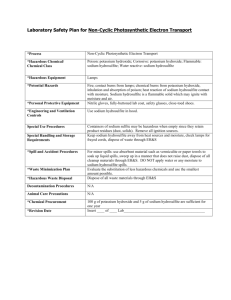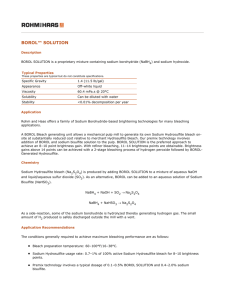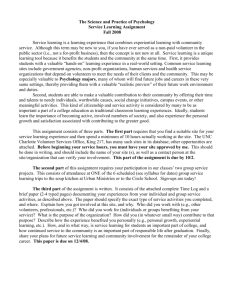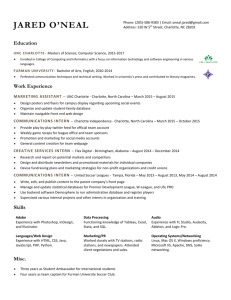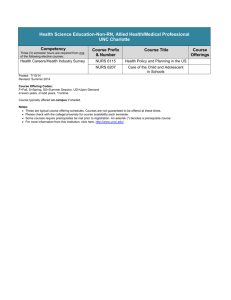Dithionate - Environmental Health & Safety
advertisement
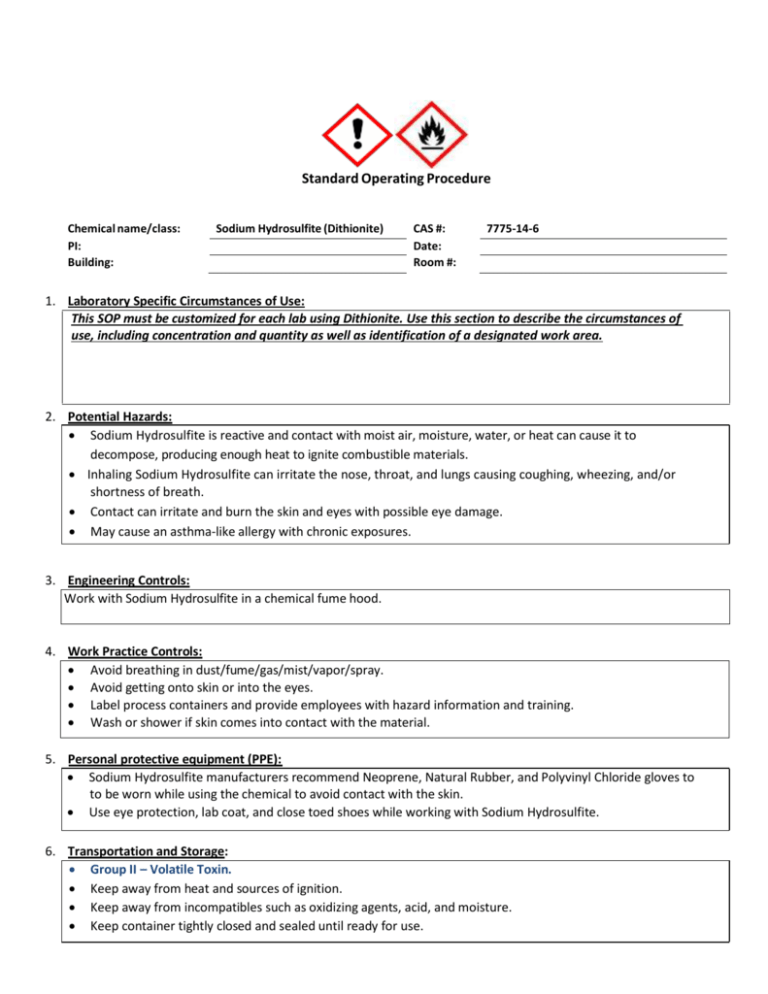
Standard Operating Procedure Chemical name/class: PI: Building: Sodium Hydrosulfite (Dithionite) CAS #: Date: Room #: 7775-14-6 1. Laboratory Specific Circumstances of Use: This SOP must be customized for each lab using Dithionite. Use this section to describe the circumstances of use, including concentration and quantity as well as identification of a designated work area. 2. Potential Hazards: Sodium Hydrosulfite is reactive and contact with moist air, moisture, water, or heat can cause it to decompose, producing enough heat to ignite combustible materials. Inhaling Sodium Hydrosulfite can irritate the nose, throat, and lungs causing coughing, wheezing, and/or shortness of breath. Contact can irritate and burn the skin and eyes with possible eye damage. May cause an asthma-like allergy with chronic exposures. 3. Engineering Controls: Work with Sodium Hydrosulfite in a chemical fume hood. 4. Work Practice Controls: Avoid breathing in dust/fume/gas/mist/vapor/spray. Avoid getting onto skin or into the eyes. Label process containers and provide employees with hazard information and training. Wash or shower if skin comes into contact with the material. 5. Personal protective equipment (PPE): Sodium Hydrosulfite manufacturers recommend Neoprene, Natural Rubber, and Polyvinyl Chloride gloves to to be worn while using the chemical to avoid contact with the skin. Use eye protection, lab coat, and close toed shoes while working with Sodium Hydrosulfite. 6. Transportation and Storage: Group II – Volatile Toxin. Keep away from heat and sources of ignition. Keep away from incompatibles such as oxidizing agents, acid, and moisture. Keep container tightly closed and sealed until ready for use. 7. Waste Disposal: Handle and store waste following the guidelines above while accumulating wastes and awaiting chemical waste pickup. Waste must be disposed of following your laboratory-specific chemical hygiene plan and the requirements of UNC Charlotte’s Laboratory Chemical Waste Management Practices http://safety.uncc.edu/laboratory-and-research-safety/hazardous-universal-waste 8. Exposures/Unintended contact: In the event of: Skin contact, immediately wash with soap and water and remove contaminated clothing. Get medical attention if a rash develops. Eye contact, immediately rinse eyes with copious amounts of water for 15 minutes while occasionally lifting upper and lower eyelids. Seek medical attention. Inhalation, move the person to fresh air immediately and seek medical attention if large amounts were inhaled. Ingestion, seek medical attention if symptoms appear. Contact the Student Health Center at 704-687-7400 for medical advice on occupational chemical exposures. For an actual chemical exposure, complete the work-related injury or illness report found at: http://safety.uncc.edu/workers-compensation/workers-compensation-section 9. Spill Procedure: Cover and mix with dry sand, earth or other noncombustible material and place into sealed, dry containers for disposal. Contact EHS at 704-687-1111 for pick-up of spill clean-up materials (including contaminated PPE). Eliminate all ignition sources and prevent moisture from contacting spilled materials. On the UNC Charlotte campus, “large” spills of volatile hazardous materials such as ether must be referred to the Campus Police by calling 911 from a campus phone or 704-687-1111 from any phone. 10. Training of personnel: All personnel are required to complete the UNC Charlotte EHS Laboratory Environment Training Checklist. This checklist includes an introduction to general chemical safety as well as review of the laboratory specific safety plan. Furthermore, all personnel shall read and fully adhere to this SOP when handling the chemical. “I have read and understand this SOP. I agree to fully adhere to its requirements.” Last First UNC Charlotte ID Signature
